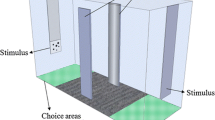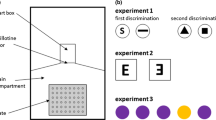Abstract
The easy-to-hard effect in perceptual learning shows that training with easier examples can facilitate initially difficult or impossible distinctions between very similar stimuli. This effect has been reported in humans and other species. We tested whether easy-to-hard training could facilitate visual discrimination in common goldfish (Carassius auratus). Fish (n = 6) performed a two-alternative forced choice discrimination task, which consisted of simultaneously presenting two striped patterns at a constant distance away on the outside of the tank. Fish were required to approach and bite a porthole corresponding to one of the stimuli for a food reward. Half of the fish were randomly assigned to a training schedule where stimuli became more similar as training progressed. The rest were trained only on the most difficult to distinguish version of the stimuli. All fish received a similar total amount of training regardless of the assigned schedule. We also examined whether performance on the first training trial for a given day was related to overall performance. Contrary to our hypothesis, fish in the easy-to-hard group did not perform significantly better than those in the constant-hard group. However, performance was found to be significantly higher on days when the first trial was correct compared to days on which it was incorrect, regardless of the type of training schedule. The current results contribute to understanding individual differences in perceptual learning in fish, and are consistent with research in humans, and other species, reporting better learning after initial reward.




Similar content being viewed by others
References
Amitay S, Moore DR, Molloy K, Halliday LF (2015) Feedback valence affects auditory perceptual learning independently of feedback probability. PLoS ONE 10(5):1–11. https://doi.org/10.1371/journal.pone.0126412
Baumeister RF, Bratslavsky E, Finkenauer C, Vohs KD (2001) Bad is stronger than good. Rev Gen Psychol 5(4):323–370
Bolker BM, Brooks ME, Clark CJ, Geange SW, Poulsen JR, Stevens MHH, White JSS (2009) Generalized linear mixed models: a practical guide for ecology and evolution. Trends Ecol Evol 24(3):127–135
Briki W (2017) Rethinking the relationship between momentum and sport performance: toward an integrative perspective. Psychol Sport Exerc 30:38–44. https://doi.org/10.1016/j.psychsport.2017.02.002
Burns JG, Rodd FH (2008) Hastiness, brain size and predation regime affect the performance of wild guppies in a spatial memory task. Anim Behav 76(3):911–922
Chittka L, Skorupski P, Raine NE (2009) Speed–accuracy tradeoffs in animal decision making. Trends Ecol Evol 24(7):400–407
Church BA, Mercado E, Wisniewski MG, Liu EH (2013) Temporal dynamics in auditory perceptual learning: Impact of sequencing and incidental learning. J Exp Psychol Learn Mem Cogn 39(1):270–276
Cook R, Fagot J (2009) First trial rewards promote 1-trial learning and prolonged memory in pigeon and baboon. Proc Natl Acad Sci 106(23):9530–9533
Crust L, Nesti M (2006) A review of psychological momentum in sports: why qualitative research is needed. Athl Insight 8(1):1–15
Daly HB (1971) Evidence for frustration during discrimination learning. J Exp Psychol 88(2):205–215
Deets AC, Harlow HF, Blomquist AJ (1970) Effects of intertrial interval and trial 1 reward during acquisition of an object-discrimination learning set in monkeys. J Comp Physiol Psychol 73(3):501–505
DeLong CM, Barbato S, O’Leary T, Wilcox KT (2017) Small and large number discrimination in goldfish (Carassius auratus) with extensive training. Behav Process 141(Part 2):172–183
Edmunds CER, Wills AJ, Milton F (2016) Initial training with difficult items does not facilitate category learning. Q J Exp Psychol 72(2):1–30
Eisler L, Spink KS (1998) Effects of scoring configuration and task cohesion on the perception of psychological momentum. J Sport Exerc Psychol 20(30):311–320
Feather NT (1966) Effects of prior success and failure on expectations of success and subsequent performance. J Pers Soc Psychol 3(3):287–298
Frech B, Vogtsberger M, Neumeyer C (2012) Visual discrimination of objects differing in spatial depth by goldfish. J Comp Physiol A 198(1):53–60
Hemmings G (1965) The effect of pretraining in the circle/square discrimination situation. Anim Behav 13(23):212–216
Hollis KL (1984) The biological function of Pavlovian conditioning: the best defense is a good offense. J Exp Psychol Anim Behav Process 10(4):413–425
Hollis KL (1999) The role of learning in the aggressive and reproductive behavior of blue gouramis, Trichogaster trichopterus. Environ Biol Fishes 54(4):355–369
Hollis KL, Dumas MJ, Singh P, Fackelman P (1995) Pavlovian conditioning of aggressive behavior in blue gourami fish (Trichogaster trichopterus): winners become winners and losers stay losers. J Comp Psychol 109(2):123–133
Hornsby AN, Love BC (2014) Improved classification of mammograms following idealized training. J Appl Res Mem Cogn 3(2):72–76
Hubbard TL (2015) Forms of momentum across time: behavioral and psychological. J Mind Behav N Y 36(1/2):47–82
Lawrence DH (1952) The transfer of a discrimination along a continuum. J Comp Physiol Psychol 45(6):511–516. https://doi.org/10.1037/h0057135
Liu EH, Mercado E, Church BA, Orduña I (2008) The easy-to-hard effect in human (Homo sapiens) and rat (Rattus norvegicus) auditory identification. J Comp Psychol 122(2):132–145
Marsh G (1969) An evaluation of three explanations for the transfer of discrimination effect. J Comp Physiol Psychol 68(2):268–275
Mitchell C, Hall G (2014) Can theories of animal discrimination explain perceptual learning in humans? Psychol Bull 140(1):283–307
Neumeyer C (2003) Wavelength dependence of visual acuity in goldfish. J Comp Physiol 189:811–821
Pashler H, Mozer MC (2013) When does fading enhance perceptual category learning? J Exp Psychol Learn Mem Cogn 39(4):1162–1173
Pavlov IP (2012) Conditioned reflexes. In: Anrep GV (ed) Mineola. Dover Publications, NY (Original work published 1927)
Roads BD, Xu B, Robinson JK, Tanaka JW (2018) The easy-to-hard training advantage with real-world medical images. Cogn Res Princ Implic 3(1):1–13. https://doi.org/10.1186/s41235-018-0131-6
Spiering BJ, Ashby FG (2008) Initial training with difficult items facilitates information integration, but not rule-based category learning. Psychol Sci 19(11):1169–1177
Sutherland NS, Mackintosh NJ, Mackintosh J (1963) Simultaneous discrimination training of octopus and transfer of discrimination along a continuum. J Comp Physiol Psychol 56(1):150–156
Walker MM, Lee Y, Bitterman ME (1990) Transfer along a continuum in the discriminative learning of honeybees (Apis mellifera). J Comp Psychol 104(1):66–70
Wisniewski MG, Radell ML, Church BA, Mercado E (2017) Benefits of fading in perceptual learning are driven by more than dimensional attention. PLoS ONE 12(7):1–20. https://doi.org/10.1371/journal.pone.0180959
Wisniewski MG, Church BA, Mercado E, Radell ML, Zakrzewski AC (2019) Easy-to-hard effects in perceptual learning depend upon the degree to which initial trials are “easy”. Psychon Bull Rev 26:1889–1895. https://doi.org/10.3758/s13423-019-01627-4
Acknowledgements
We would like to thank the undergraduate research assistants who helped with fish training and testing, including Musab Ersoy, Muhammed Yasin Cakiroglu, Olivia Rizzacasa, Jenna VanDette and Sara Vogel.
Author information
Authors and Affiliations
Contributions
All authors contributed to the study conception and design. Material preparation, data collection and analysis were performed by MLR and BMM. The first draft of the manuscript was written by MLR and all authors commented on previous versions of the manuscript. All authors read and approved the final manuscript.
Corresponding author
Ethics declarations
Conflict of interest
The authors declare that they have no conflict of interest.
Ethical approval
All applicable international, national, and/or institutional guidelines for the care and use of animals were followed.
Additional information
Publisher's Note
Springer Nature remains neutral with regard to jurisdictional claims in published maps and institutional affiliations.
Electronic supplementary material
Below is the link to the electronic supplementary material.
Rights and permissions
About this article
Cite this article
Radell, M.L., McGuire, B.M. & Fisher-Thompson, D. First trial outcome but not training difficulty predicts performance in goldfish visual discrimination. Anim Cogn 23, 741–754 (2020). https://doi.org/10.1007/s10071-020-01380-5
Received:
Revised:
Accepted:
Published:
Issue Date:
DOI: https://doi.org/10.1007/s10071-020-01380-5




